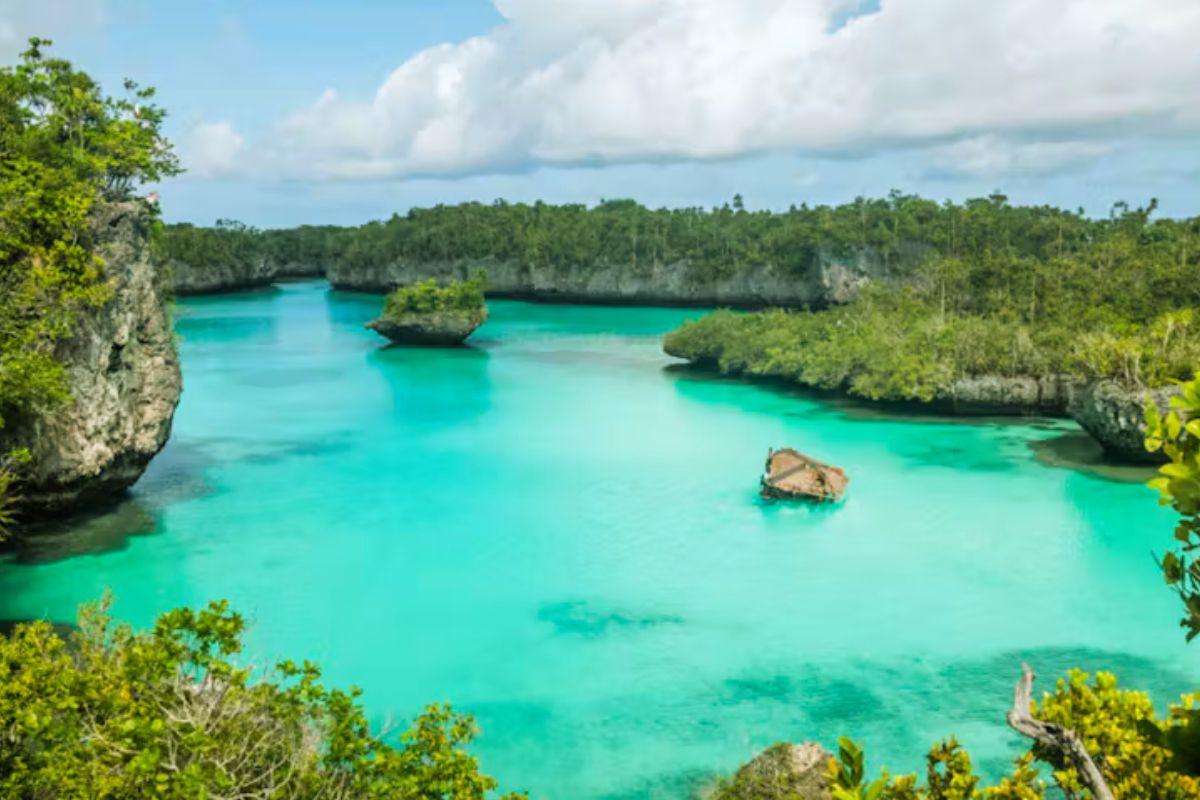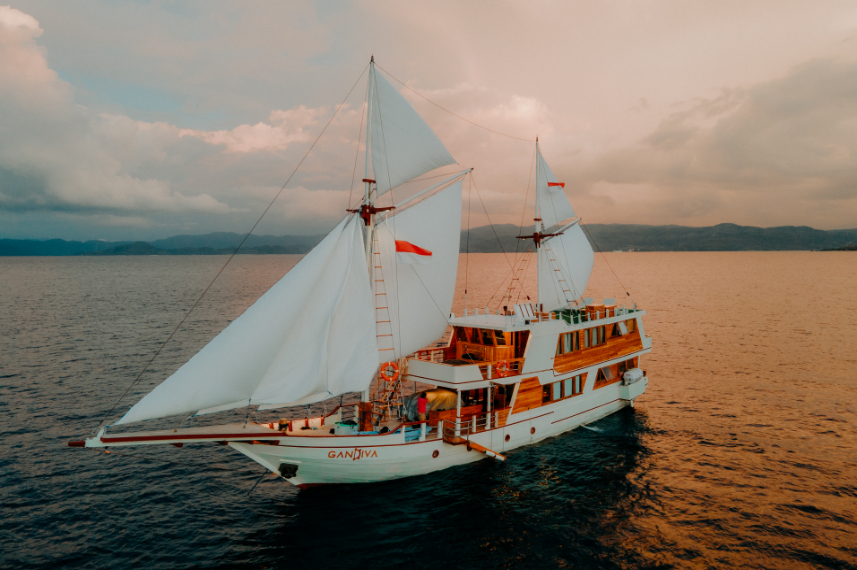Tual
Tual is geographically located within Kei/Kai Island in the southeastern part of Maluku, with Papua Island lying on the northeast. Surrounded by the Banda Sea to the west and the Arafura Sea to the east, the region is part of the Coral Triangle with incredibly high marine biodiversity.
The location of Tual and Kei Island ensures the sightings of pelagics and thriving corals. Turtles also nestle in Kei Kecil, and since 2012, the areas in the south of the island have been declared as protected areas, with WWF and volunteers working together to ensure the protection of these animals.
Top highlights of Tual
- Head to Pasir Panjang not only for one of the best stunning beaches in Indonesia but also for its colorful coral gardens
- Explore the Bair Island, known as the Little Raja Ampat of Kei Islands
- Do not miss the trip to Goa Hawang, a small cave with the clearest water you’ve ever seen
- Ngurtafur Beach during the low tide is a must as its white sand spit and the migratory pelicans are simply incredible
- Dive into Batu Jalan with its three underwater rocks and a cave resembling Swiss cheese
About Tual
Kei Islands are a group of islands in the Maluku province and part of the Forgotten Islands archipelago. Surrounded by small and uninhabited islands, the most prominent islands here are Kei Besar and Kei Kecil, with the city of Tual forming a separate regency-level administration and not being part of the Southeast Maluku Regency but located on Kei Kecil.
The history of people in the Kei Islands started during the Portuguese and Dutch battles to monopolize the spices in Banda. This exodus continued at the beginning of the 20th century until Indonesia declared independence in 1945.
The contrast between the two Kei Islands is undeniable. Kei Besar is covered in lush rainforest and mountainous areas, while Kei Kecil is where most of the population of Kei Island resides. Tual is the principal city in Kei, with the majority of the population practicing Islam, while in Langgur, a town next to Tual, most of the residents are Christian.
Pasir Panjang, an area in the west of Tual, about 17 kilometers, is known to have the best sunset spot in Indonesia.
Diving in Tual
Tual/Kei Kecil is famous for its white sandy beaches, often considered one of Indonesia’s best. But the underwater scenery offers a similar beauty. With the Arafura Sea and the Banda Sea circling the islands, it is no wonder the biodiversity here is astonishing.
Different fish species, from groupers, barracudas, tunas, jacks, trevallies, and wrasse to the smaller ones like butterflyfish, angelfish, parrotfish, clownfish, and lionfish, are plenty around Kei Kecil, does not matter where you dive. Different species of sharks, such as reef and bull sharks, are also commonly spotted in the region. Manta, eagle, and marble stingrays are regularly seen around the island.
Turtles also have a special place in Kei Kecil. Hawksbill, green, and leatherback turtles often glide gracefully across the water. The areas south of Kei Kecil have been declared protected due to the high numbers of leatherback turtles that lay their eggs there.
For macro lovers, some of the dive sites around Kei Kecil are pretty shallow, perfect for critters hunting. Denise and Bargibanti pygmy seahorses are the ones to look for among the crevices of the coral reefs, as well as different species of nudibranchs, shrimps, crabs, cuttlefish, octopus, and pipefish.
Discover your next adventure in
The Resort of Leatherback Turtles in Kei Islands
Leatherback turtles are the largest of the seven sea turtle species, and Kei Islands, especially Kei Kecil, is the home for many of these amazing creatures. This mini archipelago’s remoteness and geographical position make it possible to encounter leatherback turtles. Kei Islands are even considered one of the few reliable places to spot Pacific leatherbacks underwater.
The leatherback turtles are known to feed on jellyfish, which often comes out at night, and that’s when the turtles are most active. During the day, they can be seen resting on the surface, sunbathing to warm their bodies. The south of Kei Kecil is designated as a protected area since many of these leatherback turtles lay their eggs there. And this is where the problem arises.
The local communities still hunt leatherback turtles as subsistence due to the poor living conditions of many inhabitants of the Kei Islands. Over the last 50 years, egg harvesting and turtle hunting have reached alarming levels. Over 75% of eggs were being harvested annually, resulting in a 78% decline in the turtle population.
The situation prompted WWF and local communities to address the problem through a monitoring program to prevent egg harvesting and turtle hunting and stress the importance of the turtle’s ecosystem. Since 2017, egg poaching has fallen below 1%, and turtle hunting of adults has declined 84% since the program’s initiation.
Diving Environments in Tual
The dive sites around Tual and Kei Kecil are aimed at different levels of divers. The shallowest part ranges from 5 to 10 meters, while the deeper side can exceed 30 meters. With a variety of topography, from walls and drop-offs to coral gardens, diving in the region gives you plenty of choices according to your preference.
The visibility here is on the excellent side. During the dry season, it can reach beyond 30 meters. One of the crucial factors is the crystal-clear waters and the lack of mass tourism in the region. Like the topography, the currents around Kei Kecil vary from mild to moderate due to its geographical location, sandwiched between the Arafura Sea and the Banda Sea.
The water temperatures around the islands are constant throughout the year. The water is often within 28 to 30 degrees Celsius in the dry season, making it warm and pleasant enough to dive or snorkel. Meanwhile, the wet season brings the temperatures down to 27 to 29 degrees Celsius. There is no significant decrease as the temperatures still deliver comfortable conditions to dive.
Discover your next adventure in
How to get to Tual
Tual is reachable by plane from Ambon, with Karel Sadsuitubun Airport in Langgur as the main airport.
Direct flights are available from Jakarta to Ambon via Garuda, Citilink, and Batik Air. If you fly from Surabaya or Denpasar-Bali, there are stopovers in Surabaya and Makassar. The flight to Tual takes about 1 hour and 10 minutes, and only Lion Air has this service from Ambon.
When this article was written, there was only one flight available daily, which was in the morning, and the flight was not available every day, so kindly check regularly and schedule your flight accordingly should you wish to go to Tual.
Diving Seasons & Weather in Tual
The best diving season in this region is from March to mid-June and then from October to mid-December. This unusual pattern is due to the northwestern monsoon between December and February, which is also the rainy season with strong winds and waves. On the contrary, July and August are the southeast monsoon, which causes poor visibility and lower water temperatures, though diving is still possible.
November is known as manta season in the region. If your goal is to spot these giant fish, then make sure to visit the island during this period. Not only manta rays but also whale sharks and turtles are commonly spotted here.























